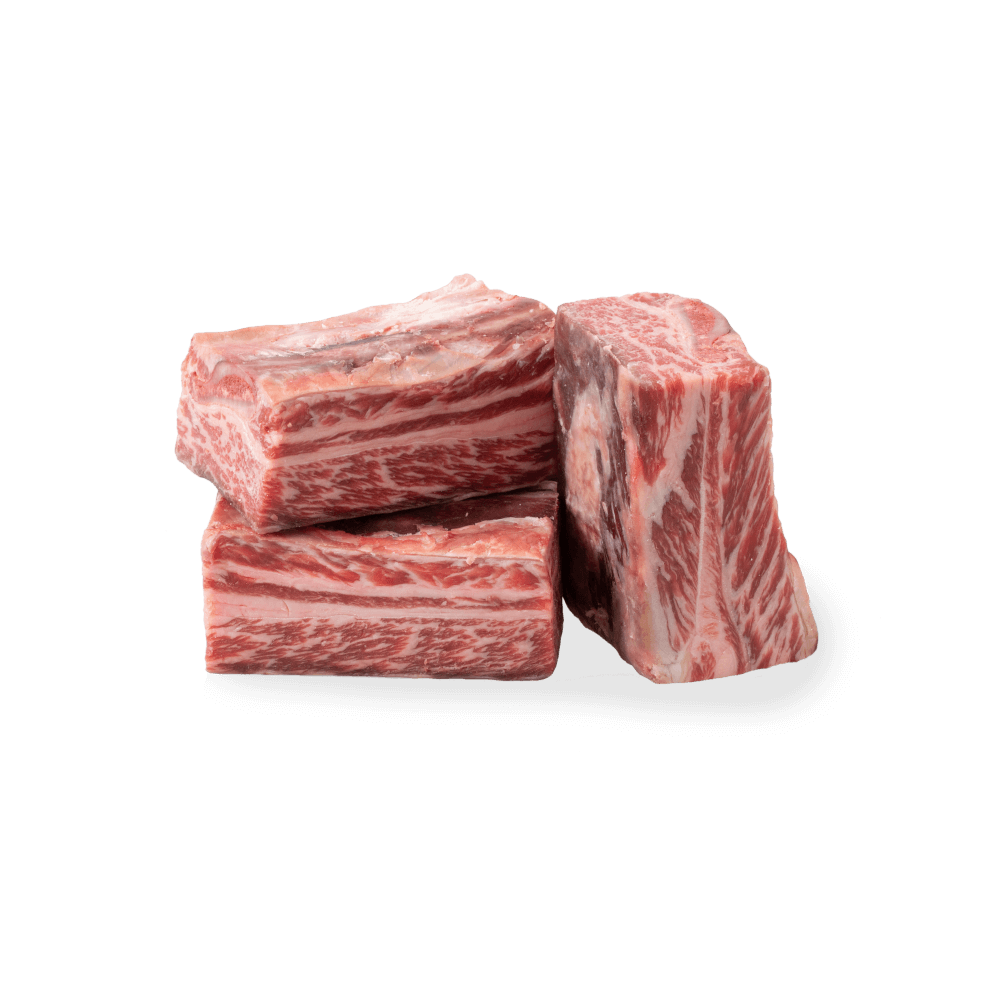 USDA Prime: these shortribs are graded USDA Prime, the top tier of quality in the US. The Prime grade indicates the highest level of marbling, resulting in increased tenderness and flavor
USDA Prime: these shortribs are graded USDA Prime, the top tier of quality in the US. The Prime grade indicates the highest level of marbling, resulting in increased tenderness and flavor
 ANGUS CATTLE: These boneless shortribs are sourced from Angus Cattle, raised in the Midwest. The naturally larger muscles of the Angus breed work in the favor of this cut – you have a higher ratio of meat to fat working with Angus shortribs than you would with the Holstein breed.
ANGUS CATTLE: These boneless shortribs are sourced from Angus Cattle, raised in the Midwest. The naturally larger muscles of the Angus breed work in the favor of this cut – you have a higher ratio of meat to fat working with Angus shortribs than you would with the Holstein breed.
 SHIP FROZEN: Flash frozen after being processed, these bone-in shortribs will be safe for an additional 6-7months in your freezer, or 4-5 days in your refrigerator once thawed.
SHIP FROZEN: Flash frozen after being processed, these bone-in shortribs will be safe for an additional 6-7months in your freezer, or 4-5 days in your refrigerator once thawed.
 UN-AGED: Two reasons why we do not dry age this particular cut – first, because there is very little protective covering that would allow us to dry age these (without enough bone or fat covering the meat, you incur too high of a trim loss when you trim the aged edges off the meat after it has finished dry aging). Secondly, whether thick cut or thin cut, these shortribs are most often paired with sauces or seasonings that are high in flavor, so we would not want to have a scenario where the dry aged flavor is competing with whatever recipe you’re going for!
UN-AGED: Two reasons why we do not dry age this particular cut – first, because there is very little protective covering that would allow us to dry age these (without enough bone or fat covering the meat, you incur too high of a trim loss when you trim the aged edges off the meat after it has finished dry aging). Secondly, whether thick cut or thin cut, these shortribs are most often paired with sauces or seasonings that are high in flavor, so we would not want to have a scenario where the dry aged flavor is competing with whatever recipe you’re going for!
Bone-in Short Ribs make me feel old. Not because of the nostalgia for the days of my youth and the memory of my mother spending an afternoon slow cooking short ribs for the family… but because I’ve been in this industry for so darn long even I can’t keep up with the different names that are used to describe short ribs!
Let’s start by all getting on the same page about the source of these short ribs – the short rib navel plate. This cut comes from the belly area of the animal, and the plate has a rectangular shape, about 8”width by 10” length. There are three bones running down the length of the plate, and the meat is situated between the bones (obviously!) and along the top of the bones.
Now, for years we would cut the plate in half lengthwise, across the bones, so that you ended up with 2 pieces, about 8” in width and 5” in length. Each piece would have 3 bones running the length of the piece, and these were called “English Cut Short Ribs”. We would accommodate individual customer requests – if someone wanted thinner cuts, we would make 3 or 4 cross cuts, which would give you a thinner length (width would stay the same). My personal favorite was to cut the portions so that you had 1.5”-2” length of bone per piece, and a few years back we put them on our site and referred to them as “English Cut” Short Ribs. Well queue up the angry emails, the masses has spoken, and I was wrong. Somewhere along the way, “English Cut” short ribs had switched and now referred to a different way of cutting the short rib plate.
This new version of English Cut short ribs were are cut lengthwise between each of the 3 bones, and then once across the bone, so that you ended up with 6 individual pieces, each one about 2-3” in width, and 5” in length, and there is only a single section of bone per piece.
What I was referring to as English Style were now called “Flanken Style”. Where that came from, I had no idea (though a quick trip down a Google rabbit hole taught me that “Flanken” referred to a European Jewish dish of, you guessed it, navel short ribs cut crosswise along the bone).
Now that I’m hip to the times, we’re using the proper nomenclature for short ribs. At least for the next few decades! So, in summary: Whatever (sigh); no matter what you call them, they are one of my favorite dishes.
In terms of cooking, I suggest to either Braise or Braise, or as an alternative, Braise. That method is what these shortribs are all about. They rank at the top of the Comfort Food list when prepared in this manner. There are a million variations ranging from “Haute Cuisine French” to “Down Home BBQ”, which gives you an idea of the versatility here. The basis of all these recipes is “low and slow”. In any method used, the meat is browned first in a skillet, then moved to a pot containing whatever sauce you have chosen and allowed to simmer slowly for a few hours. Absolute winner hint: This type of entrée (cooked in a sauce) will be better the second or third day after cooking because when left in the sauce, the meat will continue to absorb and be enhanced by the flavor of the sauce. I always make a double batch, freeze half (sauce and all) – then you have a “get out of making dinner free card”, for all you have to do is thaw and heat.
Timing can be variable; in the simplest sense, you just want to cook until the meat is fork tender. You’ll want to make sure that the individual shortrib pieces are placed in a single layer in the cooking pot (don’t stack them on top of each other), and whatever sauce you’re using should be almost covering the meat. Figure a good rule of thumb is that if you’re cooking in a 350degree oven, it’ll take about 2 and a half hours.
![]() USDA Prime: these shortribs are graded USDA Prime, the top tier of quality in the US. The Prime grade indicates the highest level of marbling, resulting in increased tenderness and flavor
USDA Prime: these shortribs are graded USDA Prime, the top tier of quality in the US. The Prime grade indicates the highest level of marbling, resulting in increased tenderness and flavor![]() ANGUS CATTLE: These boneless shortribs are sourced from Angus Cattle, raised in the Midwest. The naturally larger muscles of the Angus breed work in the favor of this cut – you have a higher ratio of meat to fat working with Angus shortribs than you would with the Holstein breed.
ANGUS CATTLE: These boneless shortribs are sourced from Angus Cattle, raised in the Midwest. The naturally larger muscles of the Angus breed work in the favor of this cut – you have a higher ratio of meat to fat working with Angus shortribs than you would with the Holstein breed.![]() SHIP FROZEN: Flash frozen after being processed, these bone-in shortribs will be safe for an additional 6-7months in your freezer, or 4-5 days in your refrigerator once thawed.
SHIP FROZEN: Flash frozen after being processed, these bone-in shortribs will be safe for an additional 6-7months in your freezer, or 4-5 days in your refrigerator once thawed.![]() UN-AGED: Two reasons why we do not dry age this particular cut – first, because there is very little protective covering that would allow us to dry age these (without enough bone or fat covering the meat, you incur too high of a trim loss when you trim the aged edges off the meat after it has finished dry aging). Secondly, whether thick cut or thin cut, these shortribs are most often paired with sauces or seasonings that are high in flavor, so we would not want to have a scenario where the dry aged flavor is competing with whatever recipe you’re going for!
UN-AGED: Two reasons why we do not dry age this particular cut – first, because there is very little protective covering that would allow us to dry age these (without enough bone or fat covering the meat, you incur too high of a trim loss when you trim the aged edges off the meat after it has finished dry aging). Secondly, whether thick cut or thin cut, these shortribs are most often paired with sauces or seasonings that are high in flavor, so we would not want to have a scenario where the dry aged flavor is competing with whatever recipe you’re going for!
